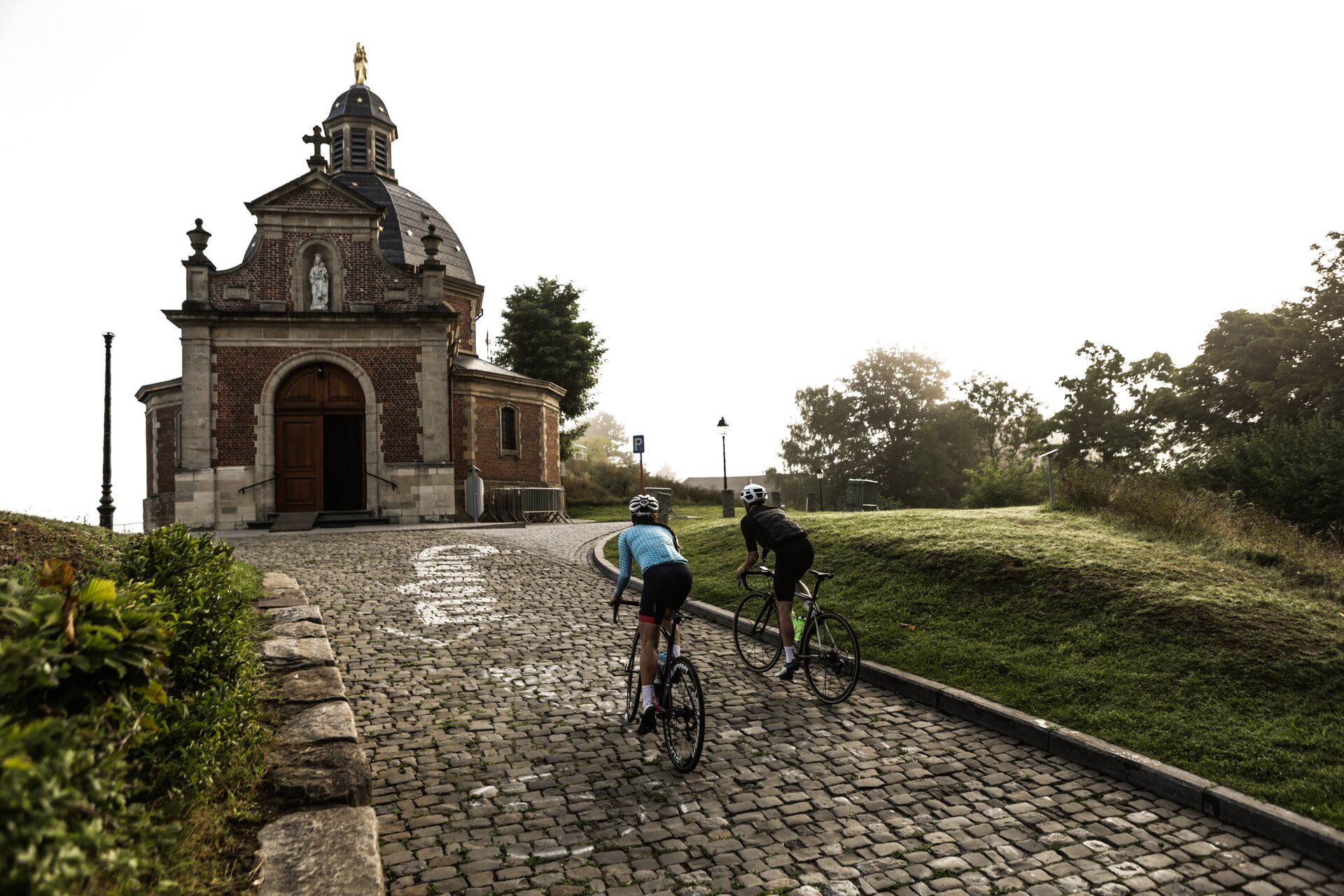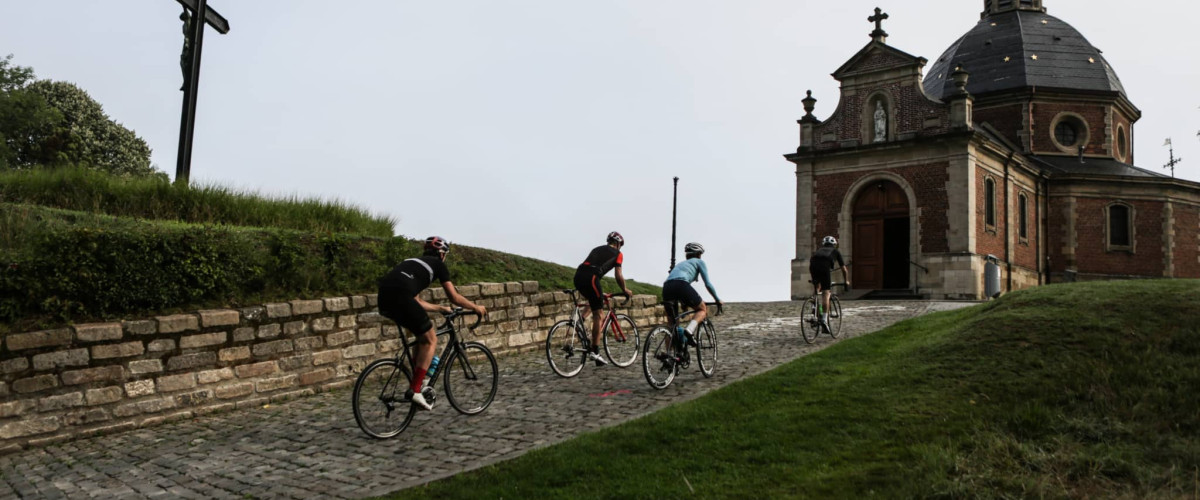The route step by step
Start
Situated close to the Tour of Flanders Centre, this is a great steep climb to start your ride. The climb was used 4 times in the Ronde (1998-2001). It's essentially a quieter and more direct route up onto the ridge that makes up the backbone of the Flemish Ardennes.The maximum gradient is 11% and you'll be rewarded at the top with a panorama of the surrounding countryside. A perfect introduction to Cycling in Flanders.
The Ladeuze is a steep climb in the Flemish Ardennes. The maximum slope is 15 %. Used for the first time in the Ronde in 2003 because of roadworks at the nearby Eikenberg, but features regularly in the women's classics. The climb has a super steep pair of bends about half way up and doesn't get much easier until you emerge on the main road between Oudenaarde and Brakel.
“Unknown is unloved" and sadly, that is the fate of this magnificent hill, Foreest in Schorisse. The fact that Foreest has only been ridden four times in the history of the Tour of Flanders no doubt has something to do with it. We first discovered the hill during a training ride in the company of former world champion mountainbiker, Filip Meirhaeghe who lives in Schorisse. We were instantly taken. Even if the climb is just 700m long, it feels for a moment like you’re in the Ardennes thanks to the peace and quiet that surrounds it. Enjoy!
This is Greg Van Avermaet's absolute favourite climb. Cyclists label this slope as ‘diabolical’. So be prepared if you want to test things out on your bike. The Berendries was climbed for the first time in the Ronde van Vlaanderen (Tour of Flanders) in 1984.
This is Greg Van Avermaet's absolute favourite climb. Boasting a maximum gradient of "only" 10% it seems to feel harder than it is, perhaps because you can always see exactly where you're going. It's usually encountered reasonably early in professional races, which means it isn't taken full-gas, but that will be of scant consolation as you grind your way up.
The curse of the Rainbow Jersey
After becoming world champion in 1996 in Lugano, Johan Museeuw dearly wanted to win his third Tour of Flanders wearing the rainbow jersey. All the signs were looking his way: Museeuw added victories in Kuurne-Brussel-Kuurne and the Three Days of De Panne, the last preparatory race before the Tour. But it wasn’t to be. At the foot of the Berendries, Museeuw the “leeuw” (“lion”) was squarely beaten by the relentless Swiss, Bruno Boscardin.
Museeuw lost the Tour of Flanders that day, which signalled the beginning of a disappointing season riddled with bad luck and few significant victories. Perhaps the curse of the rainbow jersey is real after all?
The Muur van Geraardsbergen (‘Wall of Geraardsbergen’), which has been part of the Tour of Flanders since 1950, is one of the most iconic climbs of the Ronde van Vlaanderen. Many legendary battles took place on its steep and rough cobbled road that winds up to the chapel, man to man: Schotte-Vansteenbergen, Merckx-Verbeeck, Museeuw-Van Petegem, Boonen-Cancellara…riders worshipped as gods, Flandriens reaching to the skies. More than once, the Muur was the defining moment of the Tour of Flanders. Whoever found the strength within them to conquer this 20% climb often had the key to victory at the finish line.
The legendary 'Muur van Geraardsbergen' (Grammont Wall) takes you to the 110 meter high summit of the Oudenberg. The 910m long climb has an average and maximum incline of 9% and 20% respectively. For decades De Muur was both the penultimate and decisive climb of the Ronde. Also other races such as the Three Days of De Panne, Omloop Het Nieuwsblad and BinckBank Tour use the hill to separate the men from the boys. Don’t forget to pay a visit to the lovely neo-baroque church on the top of the Kapelmuur, which will be a welcome stop after a 20% steep climb.
The rather dated joke in Geraadsbergen is that there are only three famous walls in the world, Berlin, China and theirs. You can, if you are sure you can get moving again, stop on the very roughest section to pay homage at a poetic tribute to Eddy Merckx or you can take a pause at Bar Gidon on the Market Square, which is festooned with race-worn jerseys and autographs of riders past and present. It is also headquarters to Remco Evenepoel's fanclub.
3 M'S
Geraardsbergen is particularly known for its three M's: the Muur (the Wall), Manneken Pis and the renowned local delicacy, the Mattentaart. The mattentaart is the first local dish in Flanders to be granted Protected Geographical Status by the European Commission, something it has its rich history and unique flavour to thank for. The preparation is said to descend from the middle ages when farmers wanted to find a useful purpose for their unused curdled milk. The curd was added to pastry, and voilà, the mattentaart was born. The top and bottom consist of puff pastry, the middle of a mixture of curd (which they call mat), eggs and almond. Be sure to have one – it's sweet and is the perfect food for for conquering the Wall of Geraardsbergen.
This legendary hill has become known as the ‘Edwig Van Hooydonck Hill’ since the famous Flemish cyclist made his race winning move in the Ronde van Vlaanderen there twice, next to the same lamp post, in both 1989 and 1991. The Bosberg is now the final climb in the redesigned Omloop het Nieuwsblad and features three times in the final stage of the BinckBank Tour.
The Bosberg is a wooded slope (average 5.9% and 12% max) between the Flemish Ardennes and the Pajottenland in Geraardsbergen and Galmaarden.
Some history
Bosberg used to be the last climb in the previous route of the Tour of Flanders. It was also the hill where Edwig Van Hooydonck assumed an unstoppable advantage both in 1989 and 1991, going on to win the Tour of Flanders and earn the nickname Eddy Bosberg. Bosberg was included in an important race (Omloop Het Volk – now Omloop Het Nieuwsblad) for the first time in 1950. It became part of the Tour of Flanders in 1975 as the final climb after the Muur (up to and including 1980) or the Muur-Kapelmuur (from 1981 onwards). The cobblestones on the Bosberg became a listed monument in 1993. Since the route was renewed in 2012, the Bosberg is no longer part of the Ronde. But it is included in other major races, such as the Eneco Tour and since 2018 in the Omloop.
Shake it!
This is one of the signature cobblestone roads in Flanders. The cobbles in this two kilometre stretch are rough but what makes this road really special is how it sinks in the middle, causing a slight descent at the start and a rise at the end. The Haaghoek is featured in races such as Omloop Het Nieuwsblad, E3 Harelbeke and Tour of Flanders.
With a maximum gradient of 'only' 10%, the Eikenberg looks fairly simple on paper, but the cobbles seem to go on for an awfully long time with no let up. There are bits and pieces of asphalt at the sides of the road as it climbs, offering a very brief respite to any riders who like things a bit smoother. The Eikenberg climb may not be as well known as the Oude Kwaremont or the Paterberg, but it plays a vital role in the Omloop Het Nieuwsblad as well as the Tour of Flanders.
Finish

Plan your stay
Get the hottest tips and tricks to take on Flanders by bike! When should you visit? Where can you rent a bike? What's the perfect place to stay? Or drink the perfect Belgian beer? Check it out!
Related bucketlists
Epic Stories
Those who adore cycling are bound to collect some great stories. Here they are, or at least some of them.
